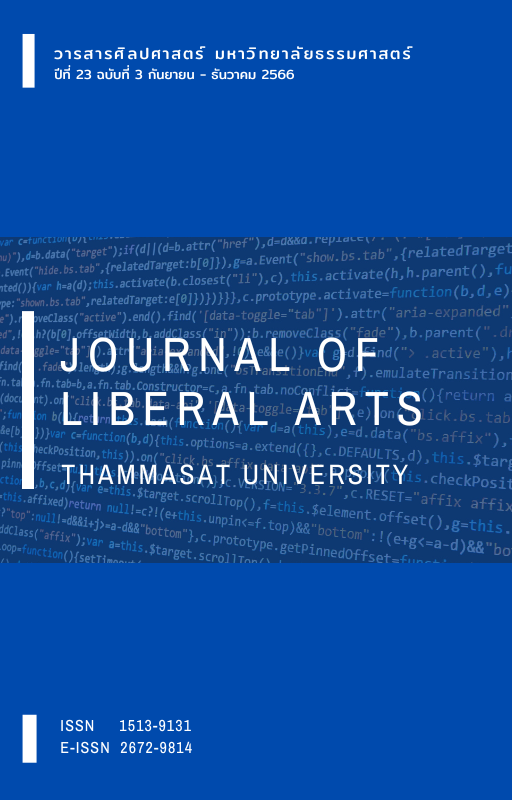A Comparative Study on Visual Cue Types in English Interrogative Pronunciation by Thai Learners
Main Article Content
Abstract
The purpose of this study is to investigate the use of different visual cue types. The first visual cue type is numbered cues. The second type is non-numbered visual cues and non-visual cues while using English interrogatives. The interrogatives included both Yes/No questions and WH questions, using pronunciation comparable to native speakers by Thai learners. Participants were thirty first-year English students studying at a university in Thailand. Target sentences were a total of thirty sentences, containing fifteen Yes/No questions and fifteen WH questions. During the test, the participants were divided into three groups that included those using numbered visual cues, non-numbered visual cues and non-visual cues. Data was analyzed using Hertz with Praat software, converted into semitone, and using Euclidean distance to find 11 equidistant intervals. The results revealed that Thai learners can pronounce English Interrogatives (Yes/No questions and WH questions) comparable to native speakers by using numbered visual cues.
Downloads
Article Details

This work is licensed under a Creative Commons Attribution-NonCommercial-NoDerivatives 4.0 International License.
References
ปัญณิตา ชัยสนิท. (2548). การพูดเพื่อการประชาสัมพันธ์ (พิมพ์ครั้งที่ 1). มหาวิทยาลัยราชภัฏ อุตรดิตถ์, คณะวิทยาการจัดการ.
ศันสนะ มูลทาดี, ทวีศักดิ์ ขันยศ, และ ชนม์ชกรณ์ วรอินทร์. (2559). การพัฒนาทักษะการพูดภาษาอังกฤษของนักเรียนชั้นมัธยมศึกษาปีที่ 5 ด้วยวิธีแสดงบทบาทสมมติ. วารสารมนุษยศาสตร์และสังคมศาสตร์ บัณฑิตวิทยาลัย มหาวิทยาลัยราชภัฏพิบูลสงคราม, 10(1), 68-83.
‘t Hart, J., Collier, R., & Cohen, A. (1990). A perceptual study of intonation: An experimental- phonetic approach. Cambridge University Press.
Abu-Snoubar, T. K. (2017). On The Relationship between listening and speaking grades of AL-Balqa applied university English as a foreign language students. International Education Studies, 12(10), 130-139.
Arias, J. P., Yoma, N. B., & Vivanco, H. (2009). Automatic intonation assessment for computer aided language learning. Speech Communication, 52(3), 254-267. https://doi.org/10.1016/j.specom.2009.11.001
Bot, D. K. (1983). Visual Feedback of Intonation I: Effectiveness and Induced Practice Behavior. Language and Speech, 6(4), 331-349.
Council of Europe. (2020). Common European framework of reference for languages: Learning, teaching, assessment - Companion volume. Council of Europe Publishing, Strasbourg.
Delongová, M. (2013). Intonation Patterns Expressing Politeness in English Requests and Commands and Their Cross-language Perception. [Doctoral dissertation]. Palacký University. https://theses.cz/id/wfk7jl/00177441-225834519.pdf
English Profile. (2013). Vocabulary Word Lists According to the CEFR. https://www.toe.gr/course/view.php?id=27
Exam English Ltd. (2019). CEFR Levels. https://www. examenglish.com/CEFR/cefr.php
Gerard, W. G. S., & Dik, J. H. (2014). A Visual Display for the Teaching of Intonation. CALICO Journal, 10(3), 19-30.
Gohil, P. P. (2013). English as a Global Language. International Journal for Research in Education, 2(2), 1-13.
Han, J. I., & Kang, H. (2013). Cross-generational change of /o/ and /u/ in Seoul Korean I: Proximity in vowel space. Phonetics and Speech Sciences (말소리와 음성과학), 5(2), 25-31. https://doi.org/10.13064/KSSS.2013.5.2.025
Harmer, J. (2007). The Practice of English Language Teaching. Harlow, Pearson Education Limited.
Hedberg, N., & Sosa, M. J. (2002). The Prosody of Questions in Natural Discourse. http://www.sfu.ca/~hedberg/HedbergSosa_final.pdf
Ke, D., & Xu, B. (2009). Chinese intonation assessment using SEV features. In IEEE International Conference on Acoustics, Speech and Signal Processing (pp. 4853-4856). https://doi.org/10.1109/ICASSP.2009.4960718
Ladd, R. (2008). Intonation Phonology. (2nd ed.). Cambridge University Press.
Luo, H., Koszalka, T., & Zuo, M. (2016). Investigating the effects of visual cues in multimedia instruction using eye tracking. In S. Cheung, Lf. Kwok, J. Shang, A. Wang, R. Kwan (Eds.), Blended Learning: Aligning Theory with Practices (pp. 63-72). Springer, Cham. https://doi.org/10.1007/978-3-319-41165-1_6
Neumeyer, V., Harrington, J., & Draxler, C. (2010). An acoustic analysis of the vowel space in young and old cochlear-implant speakers. Clinical Linguistics & Phonetics, 24(9). https://doi.org/10.3109/02699206.2010.491173
Nolan, F. (2003). Intonational equivalence: An experimental evaluation of pitch scales. In M. J. Solé, D. Recasens, & J. Romero (Eds.), Proceedings of the 15th International Congress of Phonetic Sciences (pp. 771-774). http://www.internationalphoneticassociation.org/icphs/icphs2003
Orion, F. G. (1997). Pronouncing American English Sounds, Stress, and Intonation (2nd ed.). Heinle ELT.
Oxford Placement Test. (2021). Listening Level Test. https://www.oxfordonlineenglish.com/english-level-test/listening
Pierrehumbert, J. (1980). The Phonology and Phonetics of English Intonation [Doctoral dissertation, Massachusetts Institute of Technology]. http://dspace.mit.edu/handle/1721.1/16065
Roach, P. (1943). English Phonetics and Phonology: A Practical Course. (22nd ed.). Cambridge University Press.
Silverman, K., Beckman, M., Pitrelli, J., Ostendorf, M., Wightman, C., Price, P., Pierrehumbert, J., & Hirschberg, J. (1992). TOBI: a Standard for Labeling English Prosody. In Proceedings of the 1992 International Conference on Spoken Language Processing (PLACE) (pp. 867-870). https://www.isca-speech.org/archive/icslp_1992/index.html
Taylor, D. S. (1993). Intonation and Accent in English: What Teachers Need to Know. International Review of Applied Linguistics in Language Teaching, 31, 1-21.
Tran, M. (2020). Daily English Conversation Practice. https://basicenglish speaking.com/daily-english-conversation-topics/
Wei, Y. F., & Zhou, Y. L. (2002, April 6). Insights into English Pronunciation Problems of Thai Students [Paper presentation]. The Annual Meeting of the Quadruple Helix.
Yangklang, W. (2013). Improving English stress and intonation pronunciation of the first year students of Nakhon Ratchasima Rajabhat University. Procedia Social and Behavioral Sciences, 91(3), 444-452. https://doi.org/10.1016/j.sbspro.2013.08.442
Zhao, S., Luke, K. K., Koh, S. N., & Zhang, Y. (2010). Computer Aided Evaluation of Intonation for Language Learning Based on Prosodic Unit Segmentation. Proceedings of the Second APSIPA Annual Summit and Conference, 788-793. http://www.apsipa.org/proceedings_2010/pdf/APSIPA157.pdf

